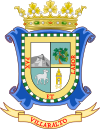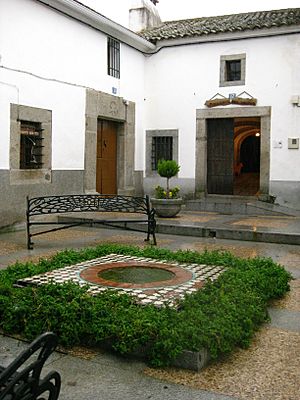Villaralto facts for kids
Quick facts for kids
Villaralto, Spain
|
|||
|---|---|---|---|
|
city
|
|||
|
|||
| Country | Spain | ||
| Province | Córdoba | ||
| Municipality | Villaralto | ||
| Area | |||
| • Total | 23 km2 (9 sq mi) | ||
| Elevation | 585 m (1,919 ft) | ||
| Population
(2018)
|
|||
| • Total | 1,154 | ||
| • Density | 50.2/km2 (129.9/sq mi) | ||
| Time zone | UTC+1 (CET) | ||
| • Summer (DST) | UTC+2 (CEST) | ||
Villaralto is a small town in the province of Córdoba, Spain. In 2018, about 1,154 people lived there. The town covers an area of 24.07 square kilometers.
Villaralto is located at an altitude of 585 meters. It is about 80 kilometers away from Cordoba, the capital city of the province. The town shares borders with other municipalities like El Viso and Dos Torres.
One of its most important buildings is the San Pedro Apóstol church. It has a tall tower built in the 1700s. The most famous event in Villaralto is the Divine Pastora pilgrimage. This festival happens every year in May by the Guadamatilla river. The town's economy relies on farming, raising animals, and local shops.
Contents
Discovering Villaralto's Past
Ancient Times: Prehistory and Roman Settlements
Villaralto has a long history, with signs of people living here since ancient times. Archaeologists have found remains from prehistoric, Roman, and Arab periods. One interesting spot is Rincon de Berrocoso. Here, experts believe there was a Roman camp or an old Roman road.
Many old items have been found, such as slate pieces, metal waste from mining, and pottery. An old silver coin from the Arab period was also discovered. The Ladrillar area was once a lead mine.
At Laguna del Prieto, three old millwheels were found. They are now kept at the City Hall. Another site, Cerrocampo, shows signs of copper or lead mining.
The most important ancient site is called Casa de la Mora. It was a Roman villa, later used by Arabs. This place was connected to mining. Many treasures were found here, including silver and copper coins. Today, you can still see pieces of pottery and Roman tiles. There are even parts of an old Arab wall.
Villaralto also has many old Visigoth stone coffins. These coffins are often trapezoid or human-shaped. Many have been moved and used as animal troughs near wells. About 20 of these old coffins exist, but many are worn down. Some smaller coffins for children have also been found. Sadly, many have disappeared over time.
How Villaralto Became a Town
The modern history of Villaralto began much later. The town was first mentioned in a document in 1424. At that time, it was a small village dependent on Torremilano. Villaralto was one of the "Seven Towns of Los Pedroches." These towns shared land and were governed together.
In 1587, a count showed that Villaralto had 83 residents. Villaralto stayed dependent on Torremilano until 1633. In July 1633, King Felipe IV sold Villaralto to Don Melchor Fernández Carreras. The price was a very large sum of money.
After the sale, Villaralto began to set its own borders. This led to a big disagreement with Torremilano. Torremilano did not want Villaralto to be independent. Despite the problems, Melchor Fernández Carreras took control of the town in September 1633. This made Villaralto a new independent area.
The dispute with Torremilano continued for a long time. Torremilano argued that Villaralto was not truly independent. They also claimed Villaralto's new borders took some of their shared land. However, in 1638, judges decided in favor of Villaralto. They officially recognized Villaralto's independence and its borders.
In 1771, Villaralto started paying taxes as an independent town for the first time. Even with their disagreements, the two towns still communicated. Villaralto also received a share of goods from the shared lands. This continued to upset Torremilano.
By 1752, Villaralto had five textile mills. It also had two factories, one for a type of cloth called baize.
Recent History of Villaralto
In 1812, records show that Villaralto had many animals, including cattle, pigs, and goats. It also had 186 houses. By 1876, the population of Villaralto grew to 1,853 people.
Unfortunately, many historical records of Villaralto were lost. This happened during the Spanish Civil War. Because of this, there are gaps in the town's history from that time. However, information from more recent times, like the Franco era and the period of democracy, is still available.
Exploring Villaralto's Art and Buildings
The San Pedro Church: A Symbol of Villaralto
The San Pedro church is very old, dating back to the 1400s. You can still see its original outer walls with decorated granite arches. Over time, the church was made bigger. It started with one main area and now has three, with smaller chapels on the sides.
Inside, there are beautiful artworks. One important statue is the Divine Pastora, made from olive wood in the 1700s. There's also a painting from the 1600s by Sebastián de Llanos Valdés. The church also has a statue of the town's patron saint, the Virgin of the Good Success. This statue replaced an older one destroyed during the Civil War.
The church's altarpiece, where the Virgin statue is, came from another church in Cordoba. This was needed because many items in San Pedro church were destroyed during the war.
The church tower is a very important part of Villaralto. It stands about 17 meters tall. It is made of granite and has a bell section with arches. Above that is an octagonal (eight-sided) part with a clock. The tower ends with a pointed top. It was built in the mid-1700s and was restored in 1992. During the restoration, its original granite was uncovered, the clock was replaced, and the bells were fixed.
Other Important Buildings
Villaralto also has other religious buildings. These include the chapel of Santa Rita, built in a square in 1900. The chapel of Cristo de las Angustias has a similar design.
Fun Traditions and Festivals
Villaralto celebrates many traditions throughout the year. During Holy Week, there are several processions. These include groups like the Hermandades del Sepulcro and Las Angustias.
The most important festival is the Romería de la Divina Pastora. It takes place on the first Sunday of May by the Guadamatilla river. People accompany the Virgin statue to the riverbank. They use beautiful and unique floats made from different materials. Women often dress in traditional shepherdess costumes.
Another tradition is the "Judas" celebration on Easter Sunday. Young people make figures of Judas Iscariot from sticks. Locals hang these figures from their balconies. Then, the young people destroy them.
Typical houses in Villaralto are built for practical use. They often have granite doorframes. Many houses also have stables or pigsties to keep animals.
You can learn more about the local way of life at the Pastor's Museum. It opened a few years ago. The museum shows how shepherds lived in different rooms, set up like a traditional Villaralto house.
Villaralto's Economy: How People Make a Living
Villaralto's economy mostly depends on farming and raising animals. The main crops grown are cereals like wheat and barley. People also grow olive trees and collect products from oak trees.
Sheep and cattle are the main animals raised. Many of these animals are sold through a company called COVAP, located in Pozoblanco.
There isn't much industry in Villaralto, but some workshops exist. These include places that work with metal, wood, and marble. A notable company is "Tegui Medioambiental SL," which makes containers for recycling materials. There is also a company that produces organic eggs and a cheese factory.
For shopping, Villaralto has small stores in the town center. These include grocery stores, clothing shops, shoe stores, and hardware stores. They provide for the basic needs of the residents. The town also has places for fun and eating, like traditional bars, coffee shops, and a pub. If you visit, try the delicious suckling pig or fried cod at one of the restaurants!
Villaralto in the Movies
Villaralto is mentioned several times in the movie "La Marrana." This film was released in 1992 and directed by José Luis Cuerda. It starred actors like Alfredo Landa and Antonio Resines.
See also
 In Spanish: Villaralto para niños
In Spanish: Villaralto para niños



